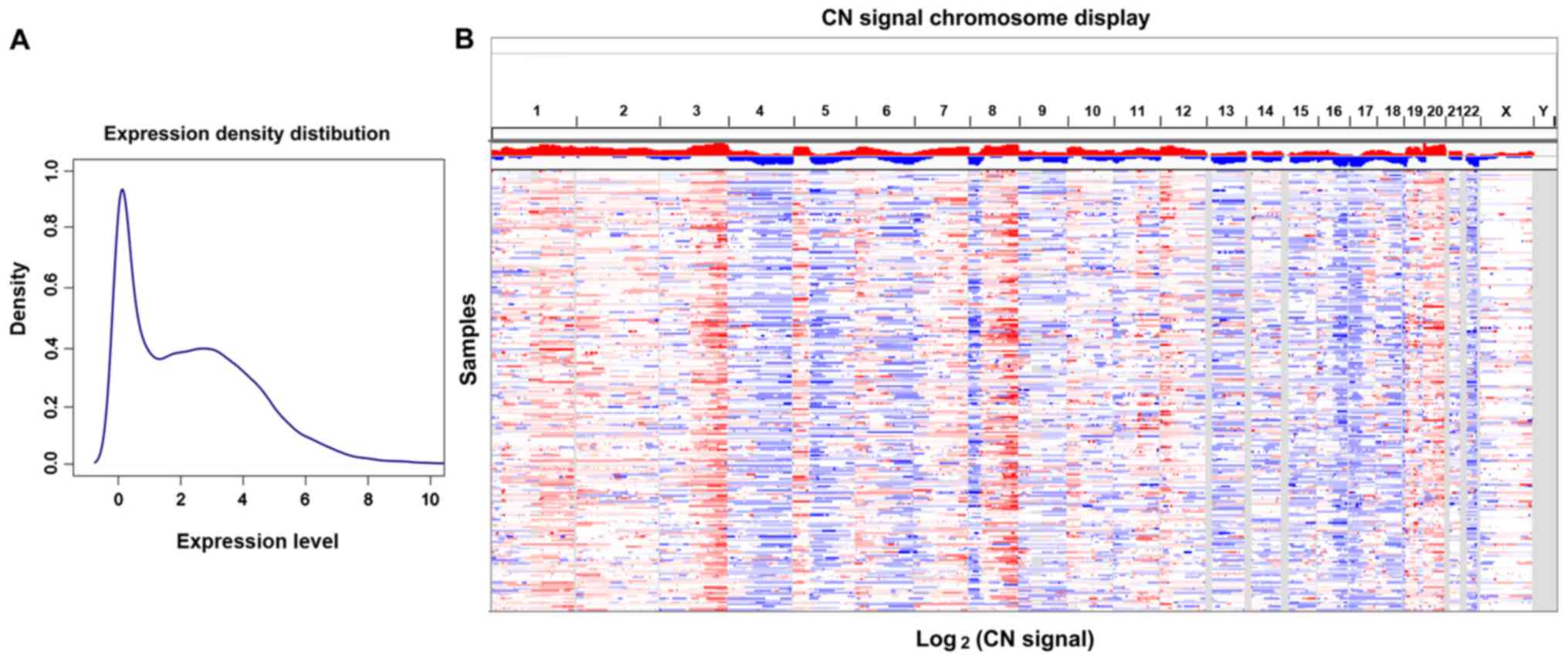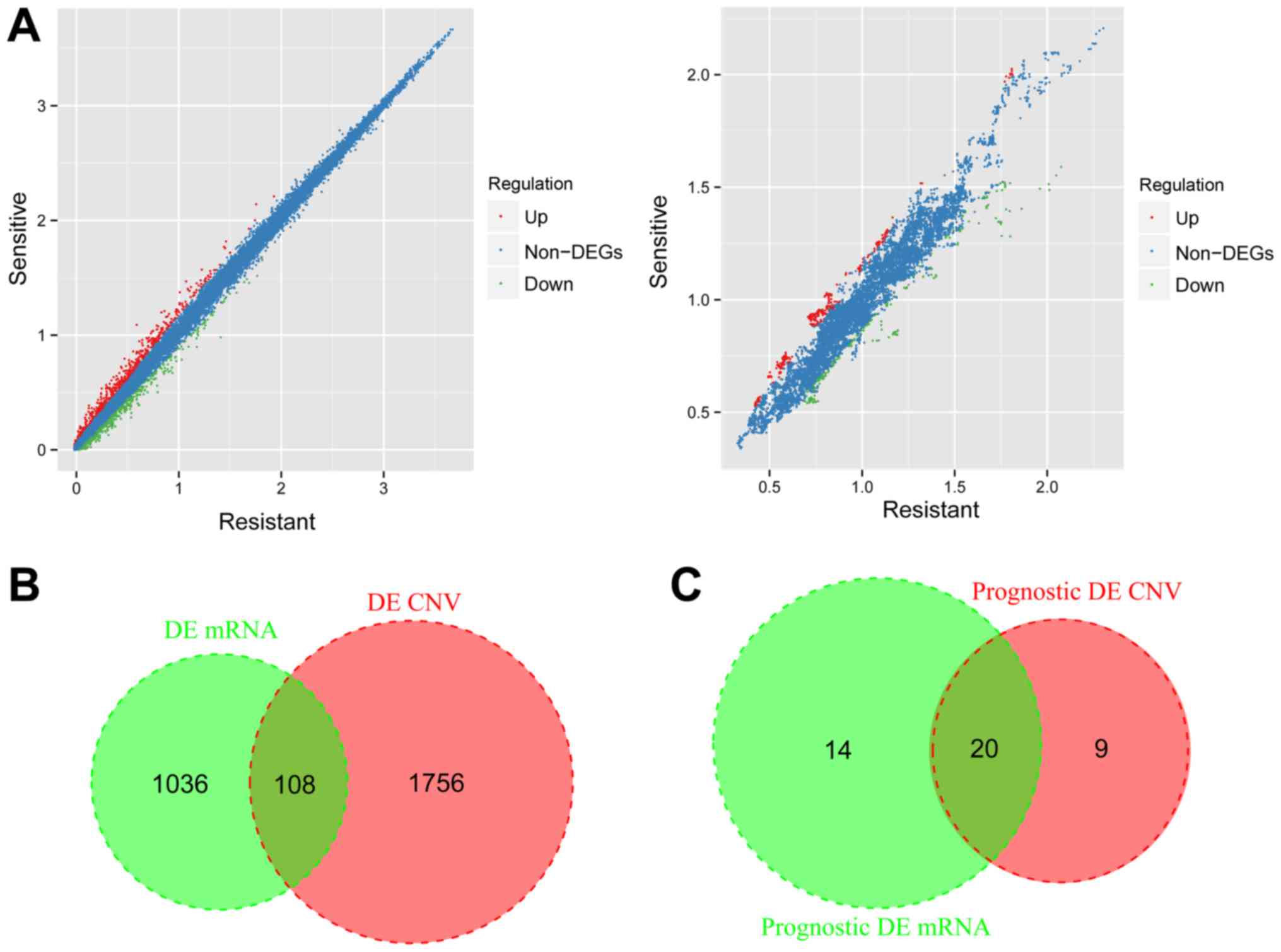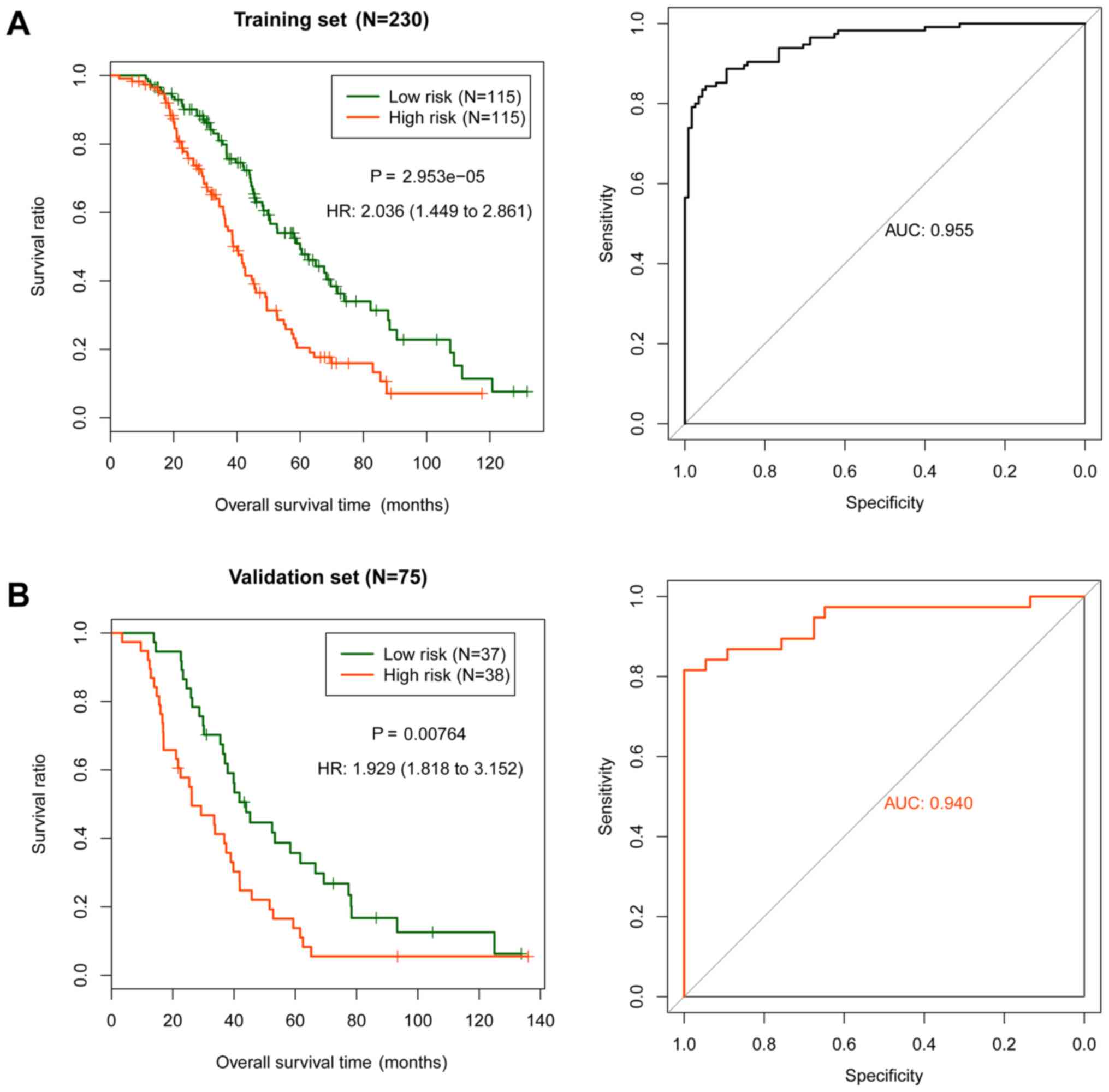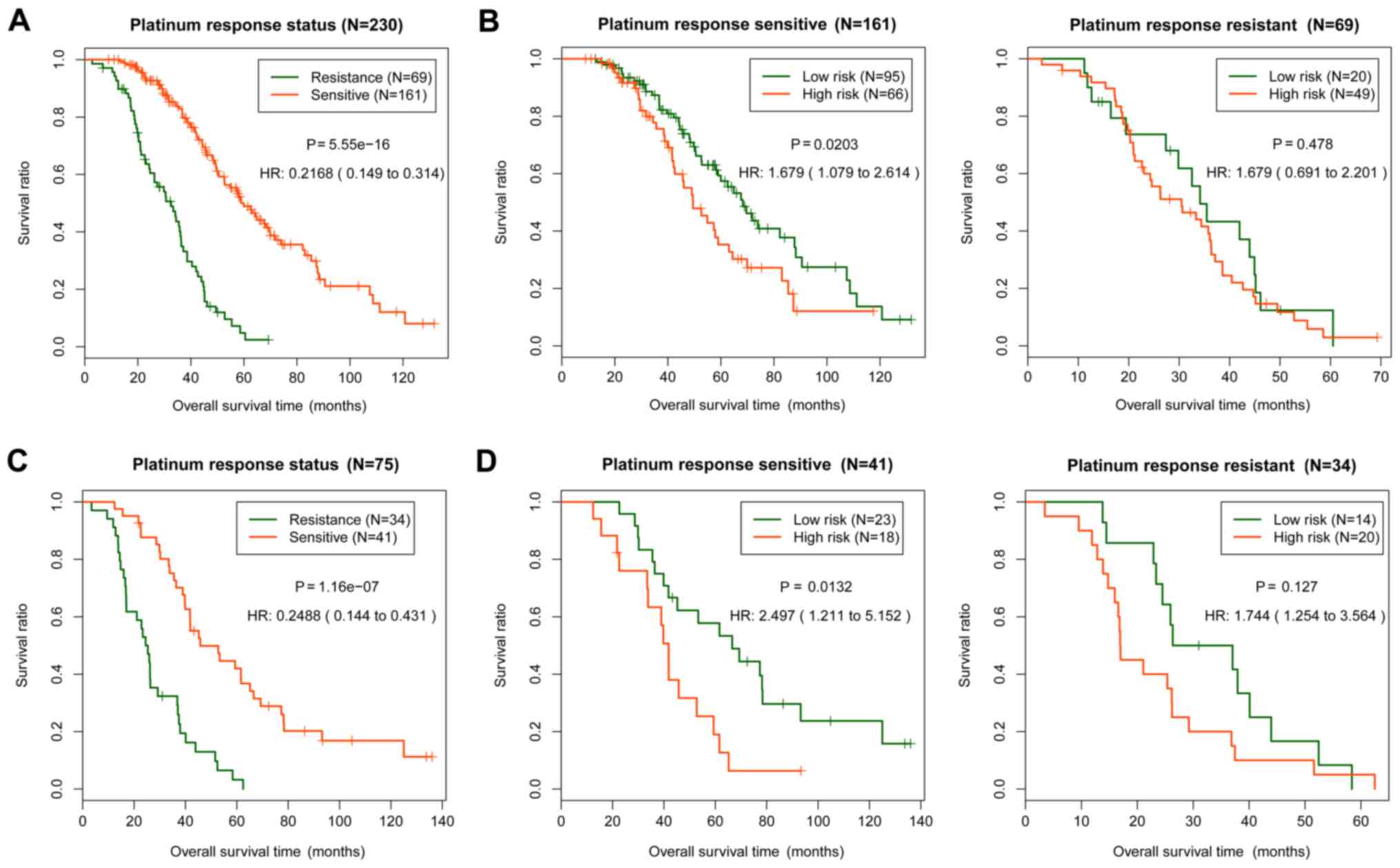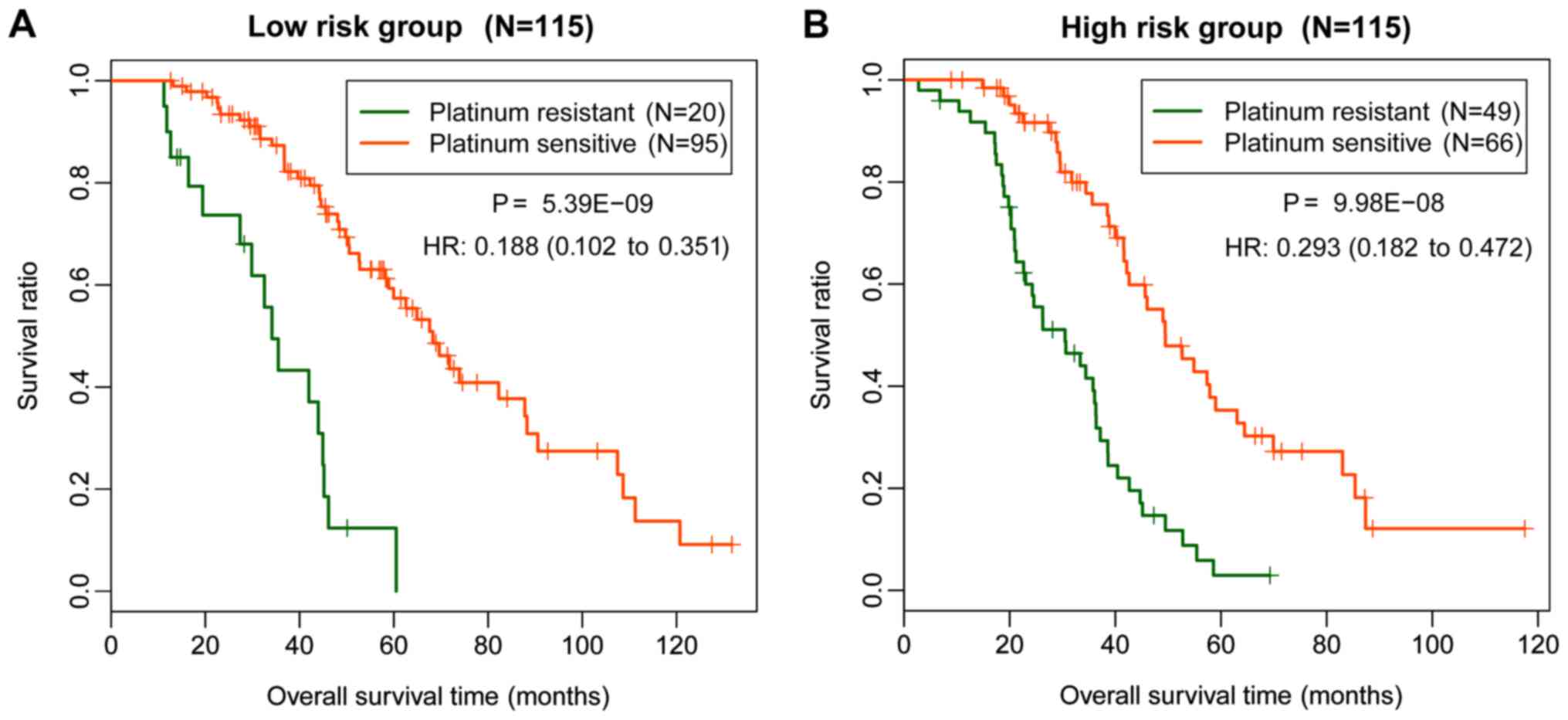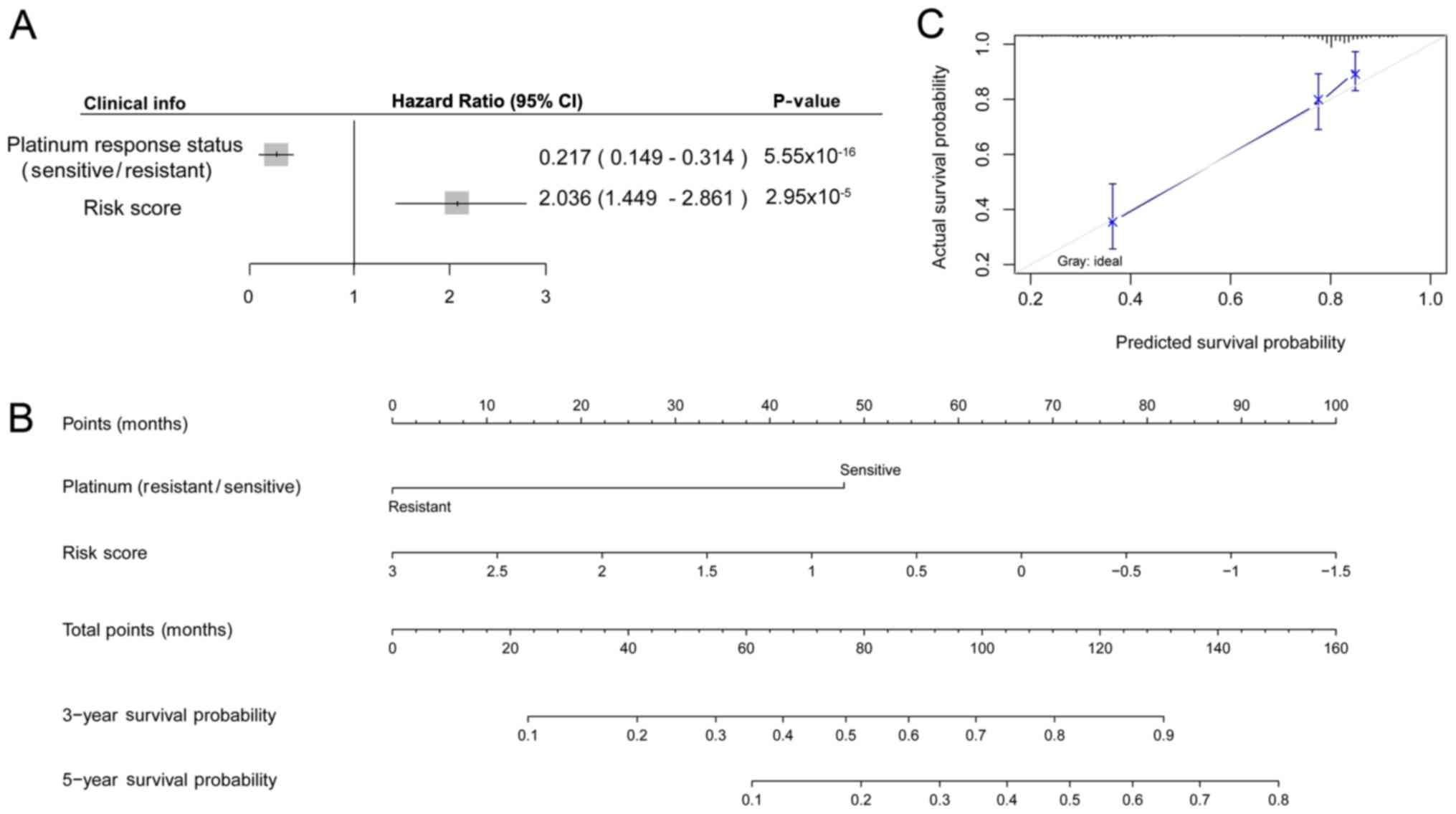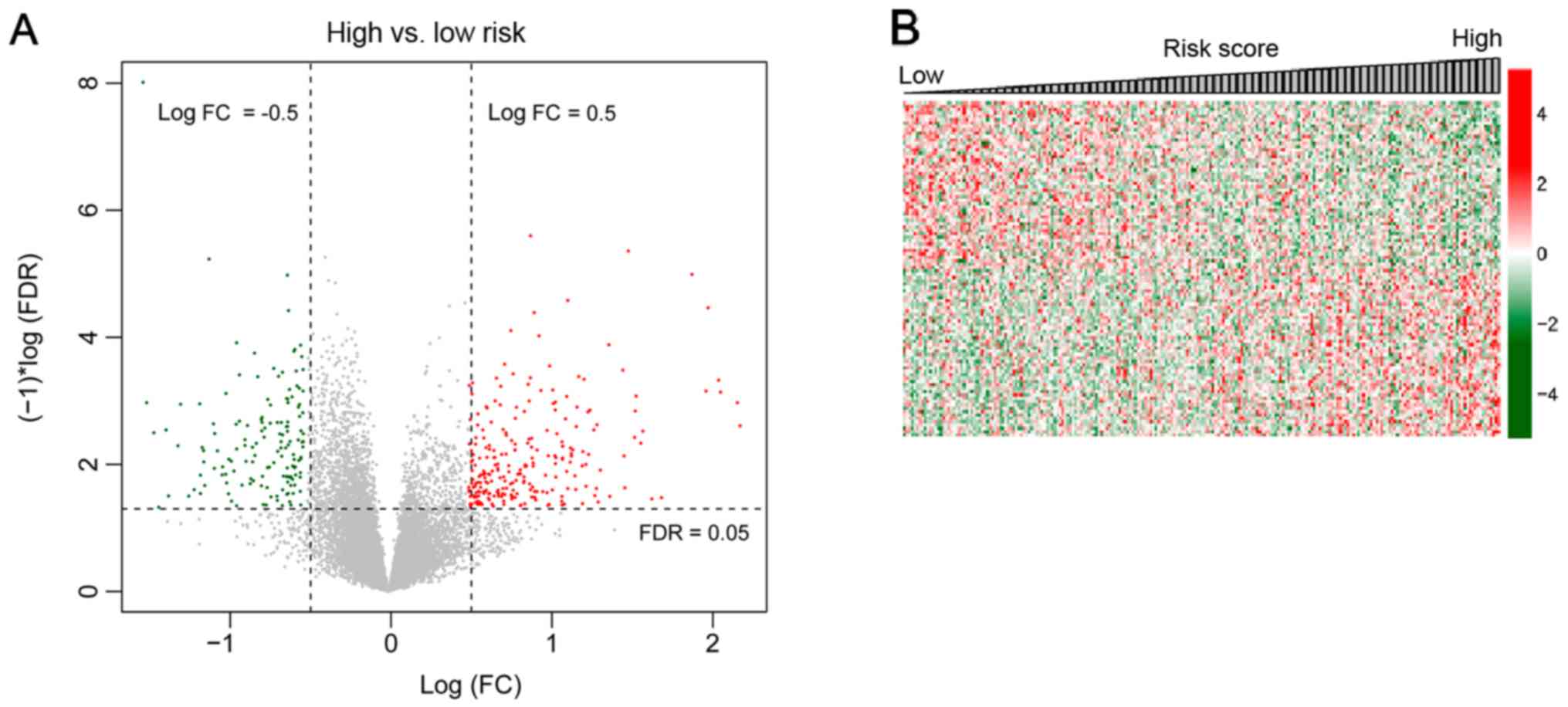Six‑mRNA risk score system and nomogram constructed for patients with ovarian cancer
- Authors:
- Published online on: May 27, 2019 https://doi.org/10.3892/ol.2019.10404
- Pages: 1235-1245
-
Copyright: © Wang et al. This is an open access article distributed under the terms of Creative Commons Attribution License.
Abstract
Introduction
Ovarian cancer (OC) affects the ovaries and may spread to the lungs, peritoneum, liver and lymph nodes (1,2). Early OC may be asymptomatic, while advanced OC is characterized by a loss of appetite, pelvic pain, bloating and abdominal swelling (3). As OC may be difficult to diagnose in the early stages, patients with OC are often diagnosed in the advanced stages of the disease and, as a result, have an unfavorable prognosis (4). Globally, OC affects 1.2 million females and was responsible for 161,100 mortalities in 2015 (5). Among gynecological tumors, OC is the third most common and has the highest mortality (6). The mechanisms underlying OC remain to be elucidated.
Phospho-H2AX expression is negatively associated with the disease-free interval in epithelial OC (EOC), and its expression may allow early diagnosis of the disease as well as the identification of patients at high risk of recurrence (7). As a potential oncogene, actinin α 4 may serve as predictive marker of poor prognosis and tumor chemoresistance in patients with advanced OC (8). Excision repair cross-complementation group 5 was revealed to be a prognostic biomarker of OC and a candidate target for the response to platinum chemotherapy treatment of patients with OC (9). Cyclin D1 (CCND1) overexpression is significantly associated with chemosensitivity and results in poor prognosis in patients with advanced serous EOC, therefore, CCND1 may serve as a novel target for treating chemoresistant tumors (10,11). Copy number variations (CNVs) of neurotrophic receptor tyrosine kinase 3 (NTRK3) were associated with platinum-resistant and platinum-sensitive relapses, and NTRK3 amplification predicted the platinum-sensitive recurrence of OC (12). The upregulation and copy number (CN) gain of cyclin E1 were detected in patients with ovarian clear cell carcinoma, and resulted in poor patient outcomes (13). Although the aforementioned genes may influence the prognosis of patients with OC, the pathways affecting OC prognosis remain to be fully elucidated.
Platinum-based drugs are effective anticancer agents and are widely used in the treatment of various solid tumors (14). Up to 80% of patients with EOC initially respond while the rest exhibit primary resistance (15). However, ≥80% of patients with EOC receiving platinum-based chemotherapy eventually develop resistance (15). The pathways underlying resistance to platinum drugs in OC have not been fully elucidated (16). An increased understanding of these pathways may serve to prevent or reverse resistance, improving the effect of treatment and the survival rate of patients with OC. The current study analyzed single nucleotide polymorphisms (SNPs) and CNVs in patients with OC using bioinformatics analyses. This resulted in the design of a risk score system, which was associated with platinum response status. The expression levels of several genes were associated with the survival prognosis of patients with OC. The results obtained the current study may provide novel and accurate markers for the diagnosis, prognosis and clinical treatment of patients with OC.
Materials and methods
Microarray data
The mRNA sequencing data from 419 OC tissue samples were analyzed using an Illumina HiSeq 2000 RNA Sequencing platform. SNP and CNV data from 481 OC tissue samples were analyzed using an Affymetrix Genome-Wide SNP Array 6.0 (Affymetrix; Thermo Fisher Scientific, Inc., Waltham, MA, USA). The datasets were downloaded from The Cancer Genome Atlas (TCGA; cancergenome.nih.gov) database. After the barcodes of the samples in the datasets were matched, a total of 230 OC samples with platinum response status and survival time information were obtained. These samples included 69 platinum-resistant samples and 161 platinum-sensitive samples and were used as the training set. The GSE63885 dataset (17) was downloaded from the Gene Expression Omnibus (GEO; http://www.ncbi.nlm.nih.gov/geo) database and analyzed using a GPL570 [HG-U133_Plus_2] Affymetrix Human Genome U133 Plus 2.0 Array platform. This dataset consisted of 101 OC tissue samples, including 75 samples with known platinum response status (34 resistant samples and 41 sensitive samples), and was used as the validation set. The clinical information of the patients from whom the samples in the training and validation sets were obtained are presented in Table I.
Table I.Clinical information of the ovarian cancer samples in the training set and the validation set. |
Data preprocessing and differential expression analysis
The preprocessCore package (18) (version 1.40.0, http://bioconductor.org/packages/release/bioc/html/preprocessCore.html) in R version 3.4.1 (https://www.r-project.org) was used to normalize the mRNA sequencing data downloaded from TCGA database. The PICNIC software (19) (the ‘predict integral copy numbers in cancer’ algorithm, ftp.sanger.ac.uk/pub/cancer) was used to convert the SNP data downloaded from the TCGA database from Cel format to segment format and to obtain CN segment data (the zero segment value indicated no CNV, and the other non-zero signal value indicated loss or amplification mutation in the detection area). Subsequently, a human gene annotation file (GRCh38.p10) (20), was downloaded from the GENCODE database (release 27; http://www.gencodegenes.org/human) and genes were annotated according to the CN area coordinates of each sample. For GSE63885, format conversion, missing value supplement, background correction and data normalization were conducted using the R package oligo (21) (version 1.42.0; www.bioconductor.org/packages/release/bioc/html/oligo.html).
Subsequent to dividing the samples in the TCGA dataset into resistant and sensitive, the differentially expressed genes (DEGs) and differentially expressed CNV genes (DECNs) were identified using the R package limma (22) (version 3.34.7; bioconductor.org/packages/release/bioc/html/limma.html) The results with false discovery rate (FDR)<0.05 and |log fold change (FC)|>0.263 were selected. The overlapping genes between DEGs and DECNs were selected. The genes with CNVs [including single nucleotide polymorphism (SNP), insertion (INS) and deletion (DEL)] were chosen for further analyses.
Identification of prognosis-associated genes and clinical factors
The aforementioned selected genes and clinical factors independently associated with prognosis were analyzed using univariate and multivariate Cox regression analysis in the R package survival (23) (version 2.41.1; cran.r-project.org/web/packages/survival/index.html). P<0.05 was considered to indicate a statistically significant difference.
Construction and assessment of the risk score system
Based on the coefficients of the independent prognostic factors in the multivariate Cox regression analysis, a gene-based risk score system was constructed for OC. The risk score of each sample was calculated according to the following formula: Risk score=Σ(coefmRNA × ExpmRNA), where coefmRNA is the prognostic coefficient of the mRNA in the multivariate Cox regression analysis and ExpmRNA is the expression level of the mRNA.
Using the median of the risk scores as a cut-off point (24,25), the samples in the training set were classified into high and low risk groups. The association between the risk score and prognosis was evaluated using the Kaplan-Meier (KM) survival curve (26) in the R package survival, and then validated in the validation set. To reveal the association of the risk score and platinum response status, the associations between the risk score and prognosis were evaluated in the resistant and sensitive group separately using univariate and multivariate Cox regression analysis.
The association between clinical factors and prognosis was also analyzed in the high and low risk groups. The clinical factors which were significantly associated with prognosis in high and low risk groups were analyzed with KM survival analysis (26).
Association between chemotherapy response and prognosis
The clinical factors significantly associated with prognosis were identified from the samples with chemotherapy response information using the Cox regression analysis in the R package survival (23). A nomogram was subsequently constructed using the R package rms (27) (version 5.1–2; cran.r-project.org/web/packages/rms/index.html). The association between the platinum response status and prognosis of patients with OC was assessed using the probabilities acquired from the nomogram.
Differential expression and pathway enrichment analysis
Using the R package limma (28), the DEGs in the high and low risk groups were analyzed. The genes with FDR<0.05 and |logFC|>0.263 were defined as DEGs. The correlation coefficient of DEGs and risk scores of samples were calculated using Cor function in R. Pathway enrichment analysis for the DEGs was subsequently performed using Gene Set Enrichment Analysis software 3.0 (29) (software.broadinstitute.org/gsea/index.jsp). P<0.05 was considered to indicate a statistically significant difference.
Results
Differential expression analysis
The mRNA expression density distribution and CN signal chromosome display of the TCGA OC dataset are presented in Fig. 1A and B. A total of 1,144 DEGs (620 upregulated and 524 downregulated) and 1,864 DECNs (1,137 upregulated and 727 downregulated) were identified in the resistant and sensitive samples (Fig. 2A). After the DEGs and DECNs were compared, a total of 108 overlapping genes were obtained (Fig. 2B). Among the overlapping genes, 48 overlapping genes with CNVs (including 94 SNPs, 1 INS and 1 DEL) were selected and performed with the following analyses.
Identification of prognosis-associated genes and clinical factors
Combined with the expression levels and CN signal levels of the 48 genes in the TCGA dataset, 34 prognosis-associated genes in expression level and 29 prognosis-associated genes in CN signal level were screened using univariate multivariate Cox regression analysis. A total of 20 overlapping genes were identified after comparing the two types of genes which were significantly associated with prognosis in expression level and CN signal level (Fig. 2C), including calcium voltage-gated channel subunit α1 C (CACNA1C), CD274 molecule, CECR2 histone acetyl-lysine reader, contactin 6, DEAQ-box RNA dependent ATPase 1, FERM domain-containing 1, growth differentiation factor 3 (GDF3), gap junction protein α8, neuroligin 1, NTRK3, PARN-like ribonuclease domain-containing 1, seizure-related 6 homolog-like, solute carrier family 22 member 3 (SLC22A3), solute carrier family 5 member 1, synemin (SYNM), synaptotagmin 9, T-box transcription factor T (TBXT), tektin 5 (TEKT5), V-set and transmembrane domain containing 2-like and ZFP57 zinc finger protein.
The 20 overlapping genes were subjected to multivariate Cox regression analysis, and a total of six independent prognostic genes (TBXT, SYNM, TEKT5, GDF3, SLC22A3 and CACNA1C) were identified (P<0.05; Table II). The CNV data of the six independent prognostic genes are presented in Table III.
Construction and assessment of the risk score system
Based on the multivariate Cox regression coefficients of the six independent prognostic genes, the following risk score system was developed (24,25): Risk score=(1.113) × ExpTBXT + (−0.625) × ExpSYNM + (0.567) × ExpTEKT5 + (0.374) × ExpGDF3 + (0.652) × ExpSLC22A3 + (0.560) × ExpCACNA1C, where Exp is the relative expression level of the genes. The risk scores of TCGA samples were calculated using the above formula. The median was used as the cut-off point to divide the samples in the training set into high and low risk groups. The association between the risk groups and prognosis was evaluated using the KM survival curve (Fig. 3A), and subsequently validated in the validation set (Fig. 3B). The association between the predictive results of the risk score system and platinum response status was further analyzed (Fig. 4). The platinum response status of the samples in the training set (P=5.55×10−16; Fig. 4A) and the validation set (P=1.16×10−07; Fig. 4C) were significantly associated with the actual prognosis. In the platinum sensitive samples, the predictive results of the training set (P=0.0203; Fig. 4B) and the validation set (P=0.0132; Fig. 4D) were significantly associated with survival prognosis. In the platinum resistant samples, the association between the predictive results and prognosis was not significant (Fig. 4B and D). Therefore, the risk score system could accurately predict the prognosis of the sensitive samples.
The samples in the training dataset were divided into high and low risk groups according to the median of the risk scores. The association between clinical factors and prognosis was determined. The platinum response status and predicted status based on the risk scores had a significant association with prognosis [platinum response status, P=1.05×10−12; hazard ratio (HR)=0.246; predicted status, P=0.0298; HR=1.489], which suggested that response to platinum treatment improves prognosis and patients with platinum sensitivity may have an improved prognosis compared with platinum-resistant patients (Table IV). Statistical analysis revealed that the platinum response status was significantly associated with the prognosis of low (P=5.39×10−09; Fig. 5A) and high (P=9.98×10−08; Fig. 5B) risk groups (Table V). The results obtained in the current study indicated that patients with platinum sensitivity in the low and high risk groups had improved survival prognosis compared with patients with platinum resistance.
Table IV.Results of the Cox regression analysis for identification of the clinical factors significantly associated with prognosis. |
Association between chemotherapy response and prognosis
Cox regression analysis was performed for the platinum response status and risk scores, revealing that the sensitive status improved prognosis in OC (HR=0.217) and that the risk score worsened the prognosis (the higher the risk score, the worse the prognosis; Fig. 6A). Subsequently, nomogram analysis was performed based on the platinum response status and risk score. The platinum response status and risk score were used as independent prognostic factors to predict the 3-year survival probability and 5-year survival probability, and the results demonstrated that patients with the sensitive status and low risk scores had improved prognosis compared with patients with platinum resistance and high risk scores (Fig. 6B). The calibration curve for the predicted 5-year survival probability and the actual survival probability revealed that the predicted curve and the ideal curve were similar. The predicted results were therefore consistent with the actual survival status according to the clinical information in the dataset (Fig. 6C).
Differential expression and pathway enrichment analyses
The OC samples in the TCGA set were divided into high and low risk groups. A total of 574 DEGs (297 upregulated and 277 downregulated) were identified in the high and low risk groups. The volcano plot of the 574 DEGs is presented in Fig. 7A. The correlation coefficient of DEGs and risk scores of samples were calculated using Cor function in R. The top 100 DEGs (the top 50 for positive and negative association, respectively) were selected for analysis based on the association of the DEGs with the risk scores. The expression heatmap is presented in Fig. 7B. Pathway enrichment analysis revealed that DEGs were significantly enriched in eight pathways, including chemokine signaling pathway, toll-like receptor signaling pathway, cytokine-cytokine receptor interaction, RIG I-like receptor signaling pathway, natural killer cell-mediated cytotoxicity, apoptosis, T cell receptor signaling pathway and Fc ε receptor 1 signaling pathway (Table VI).
Discussion
In the present study, 1,144 DEGs and 1,864 DECNs in platinum resistant samples and platinum sensitive samples were screened. A total of 108 overlapping genes between the DEGs and DECNs were identified, from which 48 genes with CNVs were selected for subsequent analyses. There were 20 genes significantly associated with prognosis in the expression level and CN signal level, from which six independent prognostic genes (T, SYNM, TEKT5, GDF3, SLC22A3 and CACNA1C) were selected. The platinum response status had a significant association with prognosis and platinum sensitivity resulted in improved prognosis. Subsequently, a risk score system based on the six independent prognostic factors was constructed and evaluated. Nomogram analysis indicated that patients with sensitive status and low risk scores had improved prognosis compared with patients with a resistant status and high risk scores. A total of 574 DEGs were identified in high and low risk groups, and these genes were enriched in eight pathways.
The Tektin (TEKT) family consists of several filament-forming proteins in male germ cells, including TEKT1, TEKT2, TEKT3, TEKT4 and TEKT5 (30). TEKT5 was reported to be a cancer/testis antigen, suggesting that TEKT5 may be used for the diagnosis and immunotherapy of patients with testicular cancer (31). SYNM is a potential tumor suppressor gene in breast cancer, and its promoter methylation status may be used to predict the risk of recurrence in patients with breast cancer (32). SYNM is an intermediate filament-associated protein that may function in the formation of hepatocellular carcinoma, and its alteration may result in the pleomorphism of tumor cells (33). Since TEKT5 and SYNM were revealed to be involved in the pathogenesis of different types of cancer in the aforementioned studies, they may also be implicated in the pathogenesis of OC.
The plasma concentration of GDF15 is increased in OC, and increased plasma concentration is negatively associated with survival time and is an independent prognostic predictor (34,35). GDF15 upregulation contributes to the growth and invasion of rapamycin-sensitive OC cells; therefore, rapamycin inhibition may be effective for treating patients with GDF15-overexpressing OC (36). GDF3 is a member of the transforming growth factor β family and is expressed in several types of tumors (37). GDF3 blocking combined with retinoic acid may be a promising therapeutic strategy for different types of solid cancer (37). GDF3 is markedly downregulated in breast cancer tissues, and its reconstitution may be a applied for inhibiting the aggressive growth of the tumor (38). Therefore, upregulation of GDF3 may also be associated with the poor prognosis of patients with OC.
SLC22A16 is expressed in ovarian clear-cell adenocarcinoma and it can promote the uptake of doxorubicin compounds directed against the cancer cells (39,40). SLC22A3 affects the absorption of numerous basic drugs and endogenous amines in multiple tissues (41). SLC22A3 is downregulated in aggressive prostate cancer and is a key risk factor for the disease (41). SLC22A3 is essential for the cytotoxicity induced by oxaliplatin as it facilitates its uptake into tumors (42). SLC22A3 expression may therefore serve as a marker for the efficacy of chemotherapy in different types of cancer (42). The results obtained in the aforementioned studies suggest that SLC22A3 may affect the efficacy of chemotherapy in patients with OC.
A limitation of the current study was a lack of experimental validation (43,44). Although bioinformatics reveals genes and pathways involved in platinum-based chemotherapy for ovarian cancer, future experiments are required to verify these results.
In conclusion, a six-mRNA risk score system was constructed to predict the prognosis of patients with OC. The risk score system-based nomogram may be applied for identifying patients with OC who will benefit from platinum chemotherapy.
Acknowledgements
Not applicable.
Funding
No funding was received.
Availability of data and materials
The datasets used during the current study are available from the corresponding author on reasonable request.
Authors' contributions
QW performed data analysis and wrote the manuscript. ZL, JM, QZ, NW, LQ, JZ and CC substantially contributed to data analysis and manuscript revision. BL conceived and designed the study. All authors read and approved the final manuscript.
Ethics approval and consent to participate
Not applicable.
Patient consent for publication
Not applicable.
Competing interests
The authors declare that they have no competing interests.
References
|
Jayson GC, Kohn EC, Kitchener HC and Ledermann JA: Ovarian cancer. Lancet. 384:1376–1388. 2014. View Article : Google Scholar : PubMed/NCBI | |
|
Cree IA: Cancer biology. Methods Mol Biol. 731:1–11. 2011. View Article : Google Scholar : PubMed/NCBI | |
|
Ebell MH, Culp MB and Radke TJ: A systematic review of symptoms for the diagnosis of ovarian cancer. Am J Prev Med. 50:384–394. 2016. View Article : Google Scholar : PubMed/NCBI | |
|
Mozzetti S, Ferlini C, Concolino P, Filippetti F, Raspaglio G, Prislei S, Gallo D, Martinelli E, Ranelletti FO, Ferrandina G and Scambia G: Class III β-Tubulin overexpression is a prominent mechanism of paclitaxel resistance in ovarian cancer patients. Clin Cancer Res. 11:298–305. 2005.PubMed/NCBI | |
|
GBD 2015 Mortality and Causes of Death Collaborators: Global, regional, and national life expectancy, all-cause mortality, and cause-specific mortality for 249 causes of death, 1980–2015: A systematic analysis for the global burden of disease study 2015. Lancet. 388:1459–1544. 2016. View Article : Google Scholar : PubMed/NCBI | |
|
McGuire S: World Cancer Report 2014. Geneva, Switzerland: World Health Organization, International Agency for Research on Cancer, WHO Press, 2015. Adv Nutr. 7:418–419. 2016. View Article : Google Scholar : PubMed/NCBI | |
|
Mei L, Hu Q, Peng J, Ruan J, Zou J, Huang Q, Liu S and Wang H: Phospho-histone H2AX is a diagnostic and prognostic marker for epithelial ovarian cancer. Int J Clin Exp Pathol. 8:5597–5602. 2015.PubMed/NCBI | |
|
Yamamoto S, Tsuda H, Honda K, Onozato K, Takano M, Tamai S, Imoto I, Inazawa J, Yamada T and Matsubara O: Actinin-4 gene amplification in ovarian cancer: A candidate oncogene associated with poor patient prognosis and tumor chemoresistance. Mod Pathol. 22:499–507. 2009. View Article : Google Scholar : PubMed/NCBI | |
|
Walsh CS, Ogawa S, Karahashi H, Scoles DR, Pavelka JC, Tran H, Miller CW, Kawamata N, Ginther C, Dering J, et al: ERCC5 is a novel biomarker of ovarian cancer prognosis. J Clin Oncol. 26:2952–2958. 2008. View Article : Google Scholar : PubMed/NCBI | |
|
Hashimoto T, Yanaihara N, Okamoto A, Nikaido T, Saito M, Takakura S, Yasuda M, Sasaki H, Ochiai K and Tanaka T: Cyclin D1 predicts the prognosis of advanced serous ovarian cancer. Exp Ther Med. 2:213–219. 2011. View Article : Google Scholar : PubMed/NCBI | |
|
Dai J, Wei RJ, Li R, Feng JB, Yu YL and Liu PS: A study of CCND1 with epithelial ovarian cancer cell proliferation and apoptosis. Eur Rev Med Pharmacol Sci. 20:4230–4235. 2016.PubMed/NCBI | |
|
Ge L, Li N, Liu M, Xu NZ, Wang MR and Wu LY: Copy number variations of neurotrophic tyrosine receptor kinase 3 (NTRK3) may predict prognosis of ovarian cancer. Medicine (Baltimore). 96:e76212017. View Article : Google Scholar : PubMed/NCBI | |
|
Ayhan A, Kuhn E, Wu RC, Ogawa H, Bahadirli-Talbott A, Mao TL, Sugimura H, Shih IM and Wang TL: CCNE1 copy-number gain and overexpression identify ovarian clear cell carcinoma with a poor prognosis. Mod Pathol. 30:297–303. 2017. View Article : Google Scholar : PubMed/NCBI | |
|
Gonzalez VM, Fuertes MA, Alonso C and Perez JM: Is cisplatin-induced cell death always produced by apoptosis? Mol Pharmacol. 59:657–663. 2001. View Article : Google Scholar : PubMed/NCBI | |
|
Yakirevich E, Sabo E, Naroditsky I, Sova Y, Lavie O and Resnick MB: Multidrug resistance-related phenotype and apoptosis-related protein expression in ovarian serous carcinomas. Gynecol Oncol. 100:152–159. 2006. View Article : Google Scholar : PubMed/NCBI | |
|
Norouzi-Barough L, Sarookhani MR, Sharifi M, Moghbelinejad S, Jangjoo S and Salehi R: Molecular mechanisms of drug resistance in ovarian cancer. J Cell Physiol. 233:4546–4562. 2018. View Article : Google Scholar : PubMed/NCBI | |
|
Lisowska KM, Olbryt M, Dudaladava V, Pamuła-Piłat J, Kujawa K, Grzybowska E, Jarząb M, Student S, Rzepecka IK, Jarząb B and Kupryjańczyk J: Gene expression analysis in ovarian cancer-faults and hints from DNA microarray study. Front Oncol. 4:62014. View Article : Google Scholar : PubMed/NCBI | |
|
Bolstad BM, Irizarry RA, Astrand M and Speed TP: A comparison of normalization methods for high density oligonucleotide array data based on variance and bias. Bioinformatics. 19:185–193. 2003. View Article : Google Scholar : PubMed/NCBI | |
|
Greenman CD, Bignell G, Butler A, Edkins S, Hinton J, Beare D, Swamy S, Santarius T, Chen L, Widaa S, et al: PICNIC: An algorithm to predict absolute allelic copy number variation with microarray cancer data. Biostatistics. 11:164–175. 2010. View Article : Google Scholar : PubMed/NCBI | |
|
Harrow J, Frankish A, Gonzalez JM, Tapanari E, Diekhans M, Kokocinski F, Aken BL, Barrell D, Zadissa A, Searle S, et al: GENCODE: The reference human genome annotation for The ENCODE Project. Genome Res. 22:1760–1774. 2012. View Article : Google Scholar : PubMed/NCBI | |
|
Parrish RS and Spencer HJ III: Effect of normalization on significance testing for oligonucleotide microarrays. J Biopharm Stat. 14:575–589. 2004. View Article : Google Scholar : PubMed/NCBI | |
|
Ritchie ME, Phipson B, Wu D, Hu Y, Law CW, Shi W and Smyth GK: Limma powers differential expression analyses for RNA-sequencing and microarray studies. Nucleic Acids Res. 43:e472015. View Article : Google Scholar : PubMed/NCBI | |
|
Wang P, Wang Y, Hang B, Zou X and Mao JH: A novel gene expression-based prognostic scoring system to predict survival in gastric cancer. Oncotarget. 7:55343–55351. 2016.PubMed/NCBI | |
|
Bao Z, Zhang W and Dong D: A potential prognostic lncRNA signature for predicting survival in patients with bladder urothelial carcinoma. Oncotarget. 8:10485–10497. 2017. View Article : Google Scholar : PubMed/NCBI | |
|
Zeng JH, Liang L, He RQ, Tang RX, Cai XY, Chen JQ, Luo DZ and Chen G: Comprehensive investigation of a novel differentially expressed lncRNA expression profile signature to assess the survival of patients with colorectal adenocarcinoma. Oncotarget. 8:16811–16828. 2017.PubMed/NCBI | |
|
Jager KJ, van Dijk PC, Zoccali C and Dekker FW: The analysis of survival data: The Kaplan-Meier method. Kidney Int. 74:560–565. 2008. View Article : Google Scholar : PubMed/NCBI | |
|
Eng KH, Schiller E and Morrell K: On representing the prognostic value of continuous gene expression biomarkers with the restricted mean survival curve. Oncotarget. 6:36308–36318. 2015. View Article : Google Scholar : PubMed/NCBI | |
|
Smyth GK: Limma: Linear models for microarray data. Bioinformatics and Computational Biology Solutions Using R and Bioconductor. Gentleman R, Carey V, Dudoit S, Irizarry R and Huber W: Springer; New York, NY: pp. 397–420. 2005, View Article : Google Scholar | |
|
Ackermann M and Strimmer K: A general modular framework for gene set enrichment analysis. BMC Bioinformatics. 10:472009. View Article : Google Scholar : PubMed/NCBI | |
|
Amos LA: The tektin family of microtubule-stabilizing proteins. Genome Biol. 9:2292008. View Article : Google Scholar : PubMed/NCBI | |
|
Hanafusa T, Mohamed AE, Domae S, Nakayama E and Ono T: Serological identification of Tektin5 as a cancer/testis antigen and its immunogenicity. BMC Cancer. 12:5202012. View Article : Google Scholar : PubMed/NCBI | |
|
Noetzel E, Rose M, Sevinc E, Hilgers RD, Hartmann A, Naami A, Knüchel R and Dahl E: Intermediate filament dynamics and breast cancer: Aberrant promoter methylation of the Synemin gene is associated with early tumor relapse. Oncogene. 29:4814–4825. 2010. View Article : Google Scholar : PubMed/NCBI | |
|
Ho CC, Ho HC, Liu YH, Pei RJ, Cheng CC, Lee KY, Yeh KT and Lai YS: Altered synemin could affect the organization of intermediate filament in human hepatocellular carcinoma. J Med. 35:171–180. 2004.PubMed/NCBI | |
|
Staff AC, Bock AJ, Becker C, Kempf T, Wollert KC and Davidson B: Growth differentiation factor-15 as a prognostic biomarker in ovarian cancer. Gynecol Oncol. 118:237–243. 2010. View Article : Google Scholar : PubMed/NCBI | |
|
Bock AJ, Stavnes HT, Kempf T, Tropè CG, Berner A, Davidson B and Staff AC: Expression and clinical role of growth differentiation factor-15 in ovarian carcinoma effusions. Int J Gynecol Cancer. 20:1448–1455. 2010.PubMed/NCBI | |
|
Griner SE, Joshi JP and Nahta R: Growth differentiation factor 15 stimulates rapamycin-sensitive ovarian cancer cell growth and invasion. Biochem Pharmacol. 85:46–58. 2013. View Article : Google Scholar : PubMed/NCBI | |
|
Tykwinska K, Lauster R, Knaus P and Rosowski M: Growth and differentiation factor 3 induces expression of genes related to differentiation in a model of cancer stem cells and protects them from retinoic acid-induced apoptosis. PLoS One. 8:e706122013. View Article : Google Scholar : PubMed/NCBI | |
|
Li Q, Ling Y and Yu L: GDF3 inhibits the growth of breast cancer cells and promotes the apoptosis induced by Taxol. J Cancer Res Clin Oncol. 138:1073–1079. 2012. View Article : Google Scholar : PubMed/NCBI | |
|
Ota K, Ito K, Akahira J, Sato N, Onogawa T, Moriya T, Unno M, Abe T, Niikura H, Takano T and Yaegashi N: Expression of organic cation transporter SLC22A16 in human epithelial ovarian cancer: A possible role of the adriamycin importer. Int J Gynecol Pathol. 26:334–340. 2007. View Article : Google Scholar : PubMed/NCBI | |
|
Ota K, Akahira JI, Sato N, Moriya T, Unno M, Abe T, Ito K and Yaegashi N: Expression of the organic cation transporter SLC22A16 can be a feature of human epithelial ovarian cancers with different histological type. J Clin Oncol. 23:51312005. View Article : Google Scholar | |
|
Chen L, Hong C, Chen EC, Yee SW, Xu L, Almof EU, Wen C, Fujii K, Johns SJ, Stryke D, et al: Genetic and epigenetic regulation of the organic cation transporter 3, SLC22A3. Pharmacogenomics J. 13:110–120. 2013. View Article : Google Scholar : PubMed/NCBI | |
|
Yokoo S, Masuda S, Yonezawa A, Terada T, Katsura T and Inui K: Significance of organic cation transporter 3 (SLC22A3) expression for the cytotoxic effect of oxaliplatin in colorectal cancer. Drug Metab Dispos. 36:2299–2306. 2008. View Article : Google Scholar : PubMed/NCBI | |
|
Tan DS, Rothermundt C, Thomas K, Bancroft E, Eeles R, Shanley S, Ardern-Jones A, Norman A, Kaye SB and Gore ME: ‘BRCAness’ syndrome in ovarian cancer: A case-control study describing the clinical features and outcome of patients with epithelial ovarian cancer associated with BRCA1 and BRCA2 mutations. J Clin Oncol. 26:5530–5536. 2008. View Article : Google Scholar : PubMed/NCBI | |
|
Gallagher DJ, Konner JA, Bell-McGuinn KM, Bhatia J, Sabbatini P, Aghajanian CA, Offit K, Barakat RR, Spriggs DR and Kauff ND: Survival in epithelial ovarian cancer: A multivariate analysis incorporating BRCA mutation status and platinum sensitivity. Ann Oncol. 22:1127–1132. 2011. View Article : Google Scholar : PubMed/NCBI |



